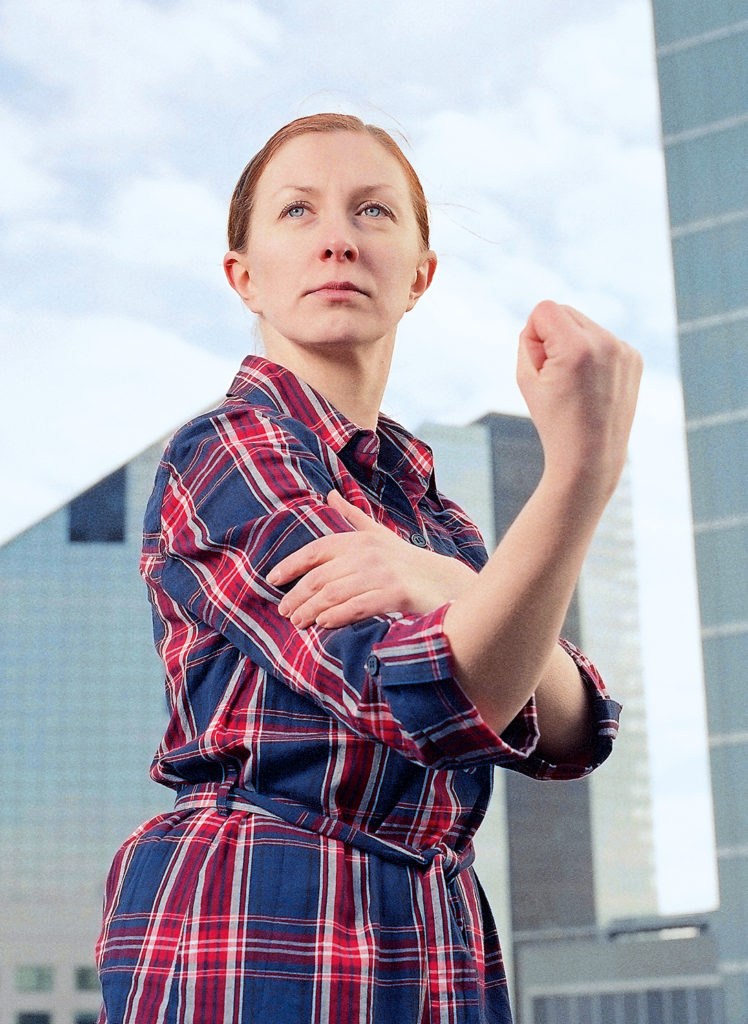
Marge Monko (1976) is an artist combining mainly photography, video and installation in her work. Her influences include feminist, psychoanalytical and visual culture theory. She focuses on themes like cultural representations of women, women’s work in a post-socialist context as well as desire for consumption and love in modern capitalist societies.
Monko first started exploring representations of women in Vienna as a Master’s student in photography, inspired by the visual archives of psychoanalysts and the work of surrealists. Her series of photographs “Studies of Bourgeoisie” (2006) bridged the gap between 19th century “hysterical femininity” and its contemporary equivalent. Monko staged scenes evoking hysteria and its treatment, exhibiting them side by side with photographs of places associated with psychoanalytical studies and Sigmund Freud. She suggested that hysteria was caused by taboos of the bourgeois society and traced how historic understanding of psychological conditions has contributed to the development of a representation of women as the weaker and emotional sex as well as that of the “mystical and compulsive woman”.
After her Master’s studies, Monko focused her attention on female workers (“Nora’s Sisters”, 2009), giving a voice to her contemporaries, women whose life was destabilised by the 2009 economic crisis and unemployment (“Forum”, 2009). This marked Monko’s turn towards the local post-socialist context, characterised by the tension between the Soviet legacy and values of the newly independent Estonia (“Shaken Not Stirred”, 2010). In her works of this period Monko was looking at issues like gender, nationality and language, highlighting that in post-socialist Estonia it is Russian-speaking women who are the most vulnerable. Monko’s projects from the end of the 2000s can be described both from the perspective of the social and documentalist turn as well as the feminist paradigm – she combines the roles of an archivist, director and documentalist, building solidarity with women from other nationalities and social groups.
In 2013, Monko presented the exhibition “How to Wear Red” at Tartu Art Museum (curated by Rael Artel) and at mumok in Vienna, which confirmed the artist’s continuous interest in the past and its manifestations in the present. The title of the show hints at the communist history and asks how to approach this legacy today. Monko tied the post-socialist context and the changing labour policies to grass roots activism and feminist themes. The work “Free Love” (2013) juxtaposed a newspaper article from 1905 of the same title and images of girls graduating from secondary school. The author of the article, Jaan Tõnisson resented the liberal ideas that had taken root in an otherwise conservative society, and in Monko’s work the comparison between the past and the present focused on the historical continuity of gender roles and hierarchy. In addition to the above mentioned works Monko also exhibited the video “Red Dawn” (2013), which discussed both the communist past and the dream of a better future.
Since 2015 Monko has been exploring the theme of the production and reproduction of desires. She has looked at the material expressions of advertising: print adverts, display of goods, display windows, etc. She is interested in the role of photography in the (re)production of desire of consumption and gender roles, using processing and subverting of existing images as her method (“Ten Past Ten”, 2015; series “Flawless, Seamless I, II”, 2017, 2019). Monko’s performance “Don’t Wind it Up, Turn it On” (2016) addresses gender roles in marketing and the relationship between love and desire. Based on Chris Kraus’ book “I Love Dick”, Monko’s “Dear D” (2015) can be interpreted as a metaphor for love letters, (auto)communicative acts driven by love and desire.
In 2018, Monko presented the solo exhibition “Stones Against Diamonds, Diamonds Against Stones” (curated by Evelien Bracke) at the Tallinn City Gallery, inspired by her long-time interest in commercial design, (re)production of gender roles and desires. Monko developed the City Gallery exposition further and presented it in 2019 at Museum Folkwang in Essen (“Diamonds Against Stones”, curated by Thomas Seelig) and in 2020 at the Russi Klenner Gallery in Berlin (“Flawless, Seamless”). In 2020 and 2021 Monko was part of the group exhibition “Modern Love (or Love in the Age of Cold Intimacies)” (curated by Katerina Gregos), displayed over 14 months in three countries (at Museum für Neue Kunst in Freiburg, Germany, Tallinn Art Hall in Estonia and Impakt Festival in Utrecht, Netherlands).
Marge Monko studied photography at the Estonian Academy of Arts (BA 2005, MA 2008) as well as at the University of Applied Arts in Vienna. From 2013 to 2015 she participated in the two-year studio programme at HISK (Higher Institute for Contemporary Art) in Ghent, Belgium. Monko is the 2012 laureate of the Henkel Art Award for Central & Eastern Europe, the same year she also received the Annual Award of the Estonian Cultural Endowment. In 2015 she was one of the first recipients of the national artist wage (2016–2017). She has shown her work in Riga Biennial of Contemporary Art RIBOCA1 (Riga, 2018), Manifesta 9 (Genk, 2012) and at COSAR HMT gallery (Düsseldorf, 2021). Her works belong to the collections of Art Museum of Estonia, Tartu Art Museum, Museum of Contemporary Art Kiasma in Helsinki, mumok Museum of Modern Art in Vienna, Muzeum Sztuki w Łodz in Poland, FRAC Lorrain, and Fotomuseum Winterthur. Since 2017 Monko works at the Estonian Academy of Arts as a professor and head of the photography department.